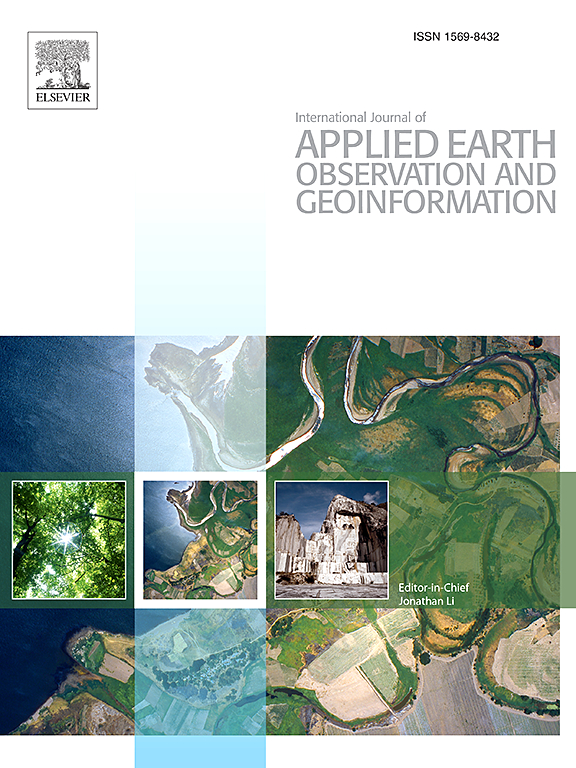Surface water mapping from remote sensing in Egypt’s dry season using an improved U-Net model with multi-scale information and attention mechanism
IF 7.6
Q1 REMOTE SENSING
International journal of applied earth observation and geoinformation : ITC journal
Pub Date : 2025-06-20
DOI:10.1016/j.jag.2025.104666
引用次数: 0
Abstract
Surface water monitoring is fundamental for managing water resources and sustaining life in arid regions worldwide. Egypt is an arid country in Northern Africa, and the surface water is critical for ecosystem health, agricultural production, and human livelihoods. During dry seasons, Egyptian water bodies exhibit unique challenges for remote sensing detection due to their significant spectral differences, complex morphological patterns, and numerous small streams. However, existing water detection methods face challenges in accurately identifying water bodies with high spatial and spectral variability, especially in arid regions during dry seasons. This paper proposes an improved U-Net model with multi-scale information and attention mechanism for precise surface water mapping by multispectral Sentinel-2 satellite images. The extraction accuracy can be improved by combining convolutional layers for local feature extraction with Vision Transformer using Manhattan self-attention for global context information. Our model attains optimal performance with IoU, F1-score, recall, and precision reaching 94.26%, 97.05%, 98.18%, and 95.94%, respectively, compared to traditional machine learning methods, particularly in challenging areas with small water bodies, complex backgrounds, and eutrophic water boundaries. Our results demonstrate that integrating multi-scale information with channel and spatial attention mechanisms can effectively address the challenges of water extraction from arid environments. This advancement in remote sensing-based water extraction could enhance water resource management in arid regions globally, contributing to the monitoring and conservation of precious water resources amid increasing environmental variability.
基于多尺度信息和关注机制的改进U-Net模型的埃及旱季地表水遥感制图
地表水监测是全球干旱地区管理水资源和维持生命的基础。埃及是北非的一个干旱国家,地表水对生态系统健康、农业生产和人类生计至关重要。在干旱季节,埃及水体由于其显著的光谱差异、复杂的形态模式和众多的小溪流,对遥感探测表现出独特的挑战。然而,现有的水探测方法在准确识别空间和光谱变化较大的水体方面面临挑战,特别是在干旱地区的旱季。本文提出了一种改进的U-Net模型,该模型具有多尺度信息和关注机制,可用于Sentinel-2卫星多光谱影像的地表水精确制图。将局部特征提取的卷积层与使用曼哈顿自关注的全局上下文信息的Vision Transformer相结合,可以提高提取精度。与传统的机器学习方法相比,我们的模型在IoU、f1分数、召回率和精度方面分别达到了94.26%、97.05%、98.18%和95.94%,特别是在具有小水体、复杂背景和富营养化水体边界的挑战性区域。研究结果表明,将多尺度信息与通道和空间关注机制相结合,可以有效地解决干旱环境中水提取的挑战。基于遥感的水提取技术的这一进展可以加强全球干旱地区的水资源管理,有助于在环境日益变化的情况下监测和保护宝贵的水资源。
本文章由计算机程序翻译,如有差异,请以英文原文为准。
求助全文
约1分钟内获得全文
求助全文
来源期刊

International journal of applied earth observation and geoinformation : ITC journal
Global and Planetary Change, Management, Monitoring, Policy and Law, Earth-Surface Processes, Computers in Earth Sciences
CiteScore
12.00
自引率
0.00%
发文量
0
审稿时长
77 days
期刊介绍:
The International Journal of Applied Earth Observation and Geoinformation publishes original papers that utilize earth observation data for natural resource and environmental inventory and management. These data primarily originate from remote sensing platforms, including satellites and aircraft, supplemented by surface and subsurface measurements. Addressing natural resources such as forests, agricultural land, soils, and water, as well as environmental concerns like biodiversity, land degradation, and hazards, the journal explores conceptual and data-driven approaches. It covers geoinformation themes like capturing, databasing, visualization, interpretation, data quality, and spatial uncertainty.
 求助内容:
求助内容: 应助结果提醒方式:
应助结果提醒方式:


